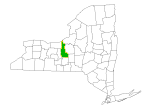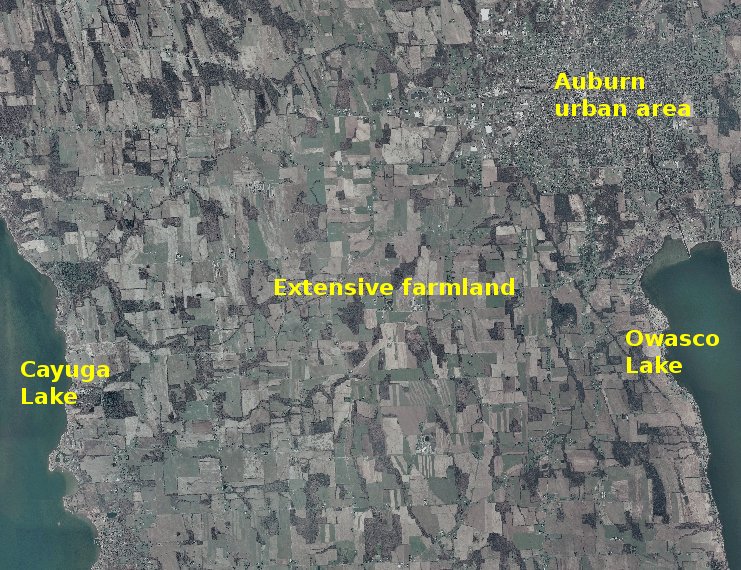Cayuga County
PDF report: pesticides-cayuga-2010

Entering Cayuga
Cayuga County was chosen as a study site because of the county’s high dependence on private wells (as is typical for rural New York) and the intensity of pesticide use, based on mapping of cumulative pesticide use in central and western NY. Unlike the three counties previously studied, there are no large public water systems that rely on ground water. We enjoyed working with the County Soil and Water Conservation District to provide local insight and to help recommend private land owners to approach about sampling their wells.
The aerial photo below captures Finger Lakes Cayuga (left) and Owasco (right), with the county’s characteristic patchwork of farmland between the lakes and the City of Auburn (drawing water supply from Owasco Lake) (upper right). Much of this farmland is in grains and corn and forage. Localized areas of vegetable and fruit production are found farther north.
In contrast to Cortland and Schenectady tested previously, Cayuga County’s ground water is in smaller surficial aquifers and a number of rural wells are drilled into shale and limestone bedrock. The Onondaga Limestone and Lockport Dolomite formations in the northern half of the county are carbonate materials subject to dissolution, which can enlarge structural joints into caverns.
Results
Cornell collected 40 samples between May 2008 and January 2009. Analysis at the DEC laboratory found no detectable levels of any pesticide tested, with detection limits of 1 µg/L or less. The more sensitive ELISA immunoassay tests run at Cornell found trace or quantifiable low levels of the herbicides atrazine, alachlor, and metolachlor in 12 of 40 wells. None of these results exceed any drinking water or environmental standards. Of the 12 wells, two had quantifiable detections of atrazine (0.21 to 0.26 μg/L, much lower than the 3 µg/L drinking water standard) and one well had a quantifiable detection of alachlor (0.18 µg/L; no drinking water standard). In addition, there were five lower trace detections of atrazine, one of alachlor and six of metolachlor (no drinking water standard). Three of these 12 wells had two herbicides detected (alachlor+metolachlor or atrazine+metolachlor).
All nitrate-N concentrations were below 10 mg N/L, the greatest observed value being 9.3 mg/L. Seven wells had concentrations in excess of 5 mg N/L; of these, six were shallow wells. In general, those wells generally considered more vulnerable due to shallow depth, type of construction, and proximity to pesticide use areas tended to have higher nitrate and ELISA pesticide test results. Of these more vulnerable wells, five were resampled in June 2009. Nitrate and DEC pesticide results were similar to earlier sampling results, and the number of trace and quantified levels detected by immunoassays declined somewhat.
This fourth round of sampling in Cayuga County was followed by work in Genesee County.
Later resampling
Cayuga County was sampled originally in 2008-2009, some wells were revisited once in mid 2009, and there were two rounds of seasonal sampling in 2014 and 2016-2017. (One location of the 2016-2017 round, CyC-08P, was a pond receiving tile drainage thus probably reflecting shallow groundwater.) As in Cortland the metolachlor ESA metabolite was the most commonly found analyte and the similar metolachlor OA was also found widely. Atrazine metabolites were present at lower levels in three locations in the 2016-2017 period, and the parent atrazine was present via both ELISA and DEC lab tests for three wells.
Fully detailed resampling results, with the original results from the same wells, are included in a PDF:

Aerial view of Auburn, Cayuga Lake, and Owasco Lake
Last updated 2023-09-21 sp17 AT Cornell.edu.